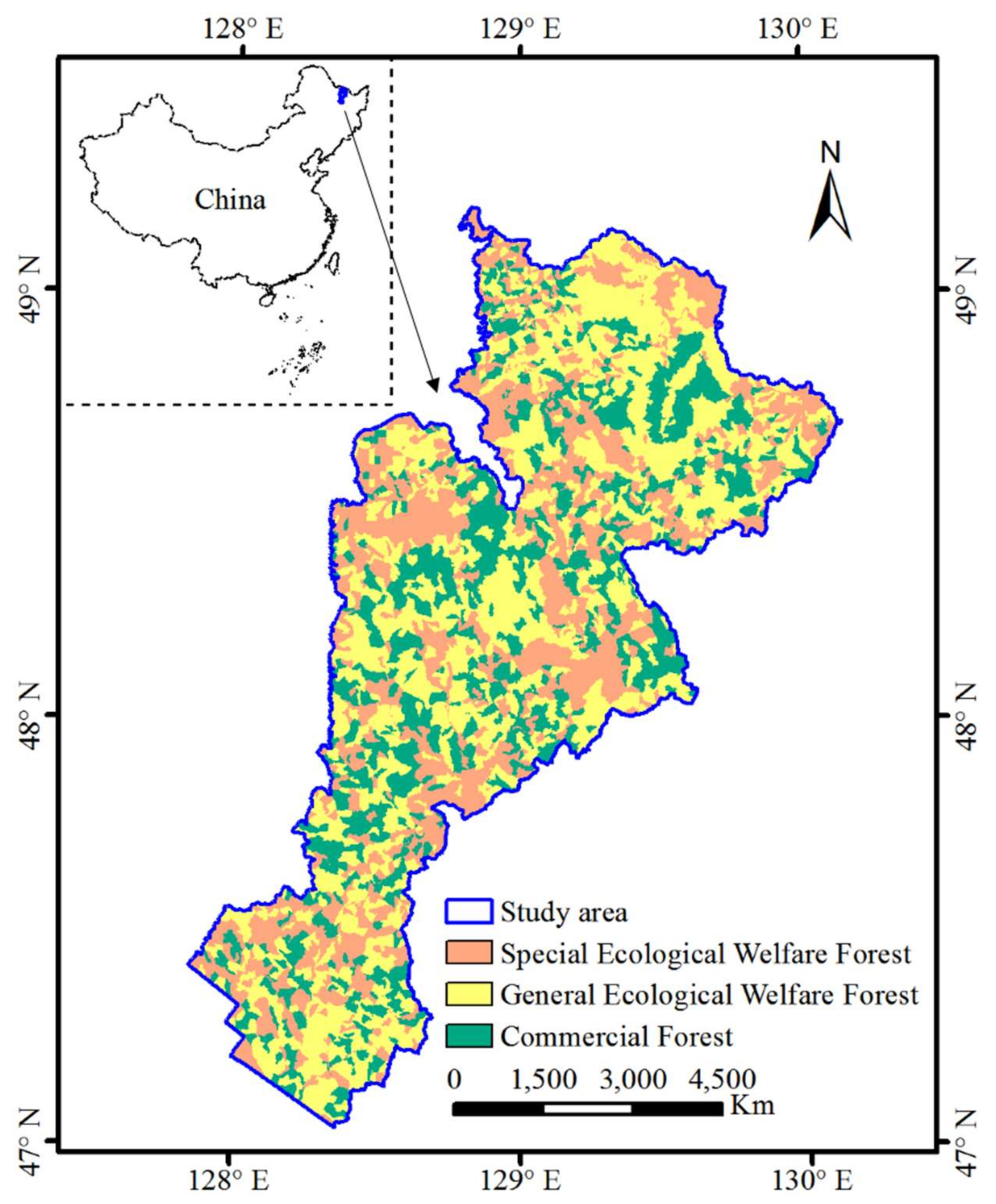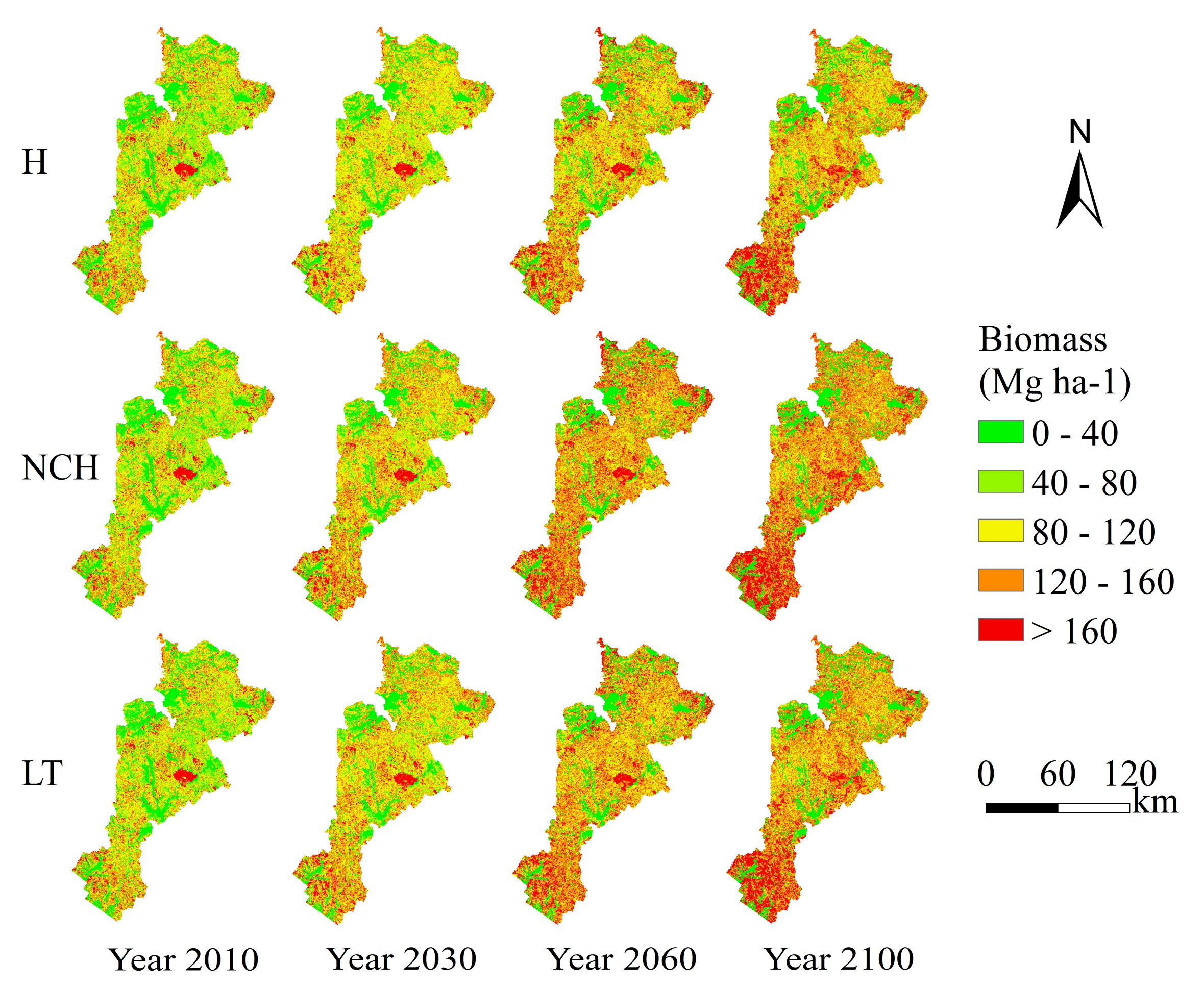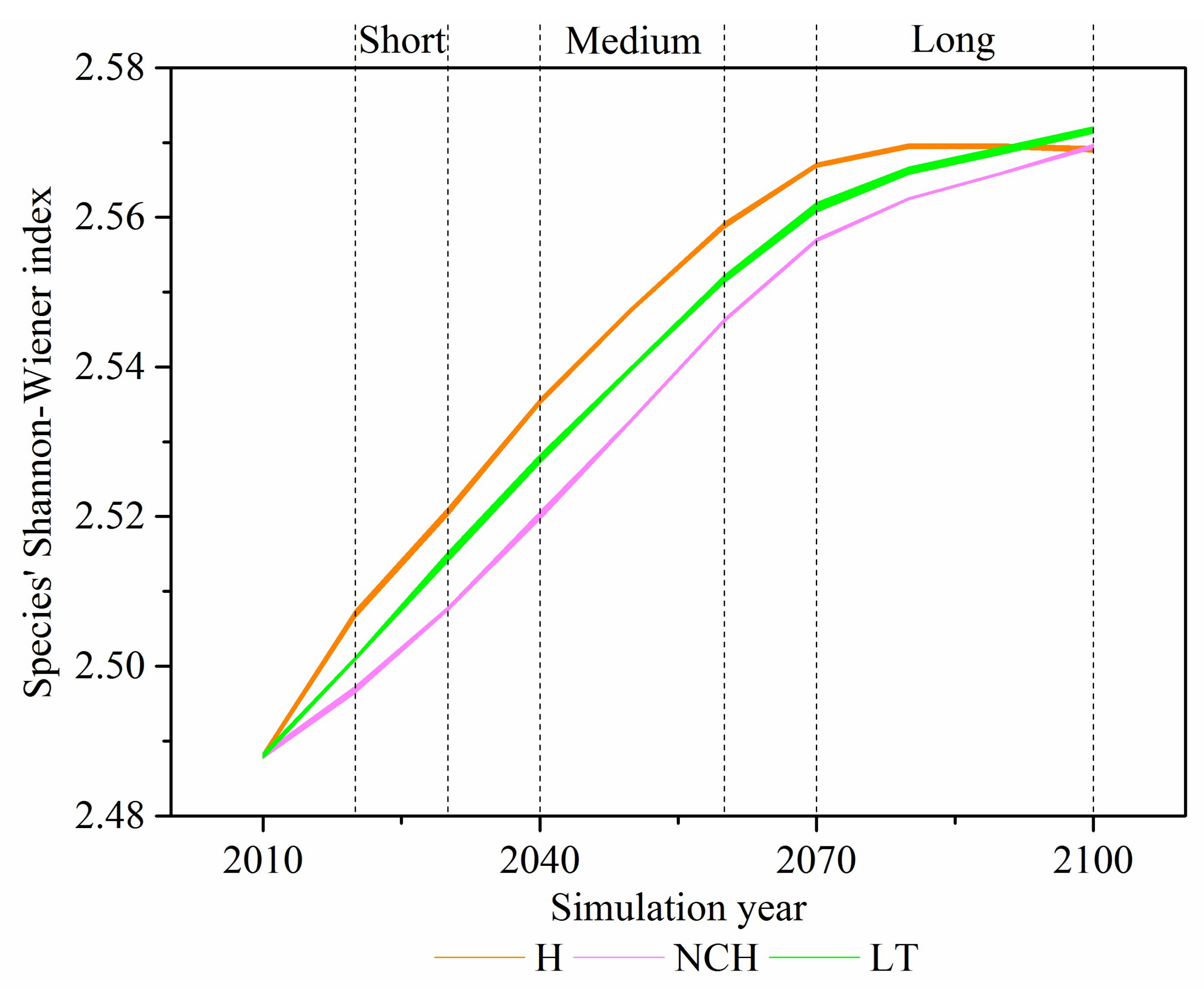Long-Term Impacts of China’s New Commercial Harvest Exclusion Policy on Ecosystem Services and Biodiversity in the Temperate Forests of Northeast China
Abstract
:1. Introduction
2. Materials and Methods
2.1. Study Area
2.2. Experimental Design
2.3. LANDIS PRO 7.0 Model
2.3.1. Model Description
2.3.2. Model Parameterization
2.3.3. Model Initialization
2.4. Data Analysis
3. Results
3.1. Aboveground Biomass
3.2. Diversity of Tree Species and Forest Age Class
4. Discussion
5. Conclusions
Acknowledgments
Author Contributions
Conflicts of Interest
References
- Heinonen, T.; Pukkala, T.; Mehtätalo, L.; Asikainen, A.; Kangas, J.; Peltola, H. Scenario analyses for the effects of harvesting intensity on development of forest resources, timber supply, carbon balance and biodiversity of Finnish forestry. For. Policy Econ. 2017, 80, 80–98. [Google Scholar] [CrossRef]
- Kline, J.D.; Harmon, M.E.; Spies, T.A.; Morzillo, A.T.; Pabst, R.J.; McComb, B.C.; Schnekenburger, F.; Olsen, K.A.; Csuti, B.; Vogeler, J.C. Evaluating carbon storage, timber harvest, and potential habitat possibilities for a western Cascades (US) forest landscape. Ecol. Appl. 2016, 26, 2044–2059. [Google Scholar] [CrossRef] [PubMed]
- Shifley, S.R.; Thompson, F.R.; Dijak, W.D.; Fan, Z. Forecasting landscape-scale, cumulative effects of forest management on vegetation and wildlife habitat: A case study of issues, limitations, and opportunities. For. Ecol. Manag. 2008, 254, 474–483. [Google Scholar] [CrossRef]
- Gustafsson, L.; Baker, S.C.; Bauhus, J.; Beese, W.J.; Brodie, A.; Kouki, J.; Lindenmayer, D.B.; Lõhmus, A.; Pastur, G.M.; Messier, C. Retention forestry to maintain multifunctional forests: A world perspective. BioScience 2012, 62, 633–645. [Google Scholar] [CrossRef]
- Zanchi, G.; Belyazid, S.; Akselsson, C.; Yu, L. Modelling the effects of management intensification on multiple forest services: A Swedish case study. Ecol. Model. 2014, 284, 48–59. [Google Scholar] [CrossRef]
- D’Amato, A.W.; Bradford, J.B.; Fraver, S.; Palik, B.J. Forest management for mitigation and adaptation to climate change: Insights from long-term silviculture experiments. For. Ecol. Manag. 2011, 262, 803–816. [Google Scholar] [CrossRef]
- Shifley, S.R.; Aguilar, F.X.; Song, N.; Stewart, S.; Nowak, D.; Gormanson, D.; Moser, K.; Wormstead, S.; Greenfield, E.J. Forest of North America Executive summary. In Forests of the Northern United States; U.S. Department of Agriculture, Forest Service, Northern Research Station: Newtown Square, PA, USA, 2012; 40p. [Google Scholar]
- Barreto, P.; Amaral, P.; Vidal, E.; Uhl, C. Costs and benefits of forest management for timber production in eastern Amazonia. For. Ecol. Manag. 1998, 108, 9–26. [Google Scholar] [CrossRef]
- Yu, D.; Zhou, L.; Zhou, W.; Ding, H.; Wang, Q.; Wang, Y.; Wu, X.; Dai, L. Forest management in Northeast China: History, problems, and challenges. Environ. Manag. 2011, 48, 1122–1135. [Google Scholar] [CrossRef] [PubMed]
- Sodhi, N.S.; Koh, L.P.; Brook, B.W.; Ng, P.K. Southeast Asian biodiversity: An impending disaster. Trends Ecol. Evol. 2004, 19, 654–660. [Google Scholar] [CrossRef] [PubMed]
- Ciccarese, L.; Mattsson, A.; Pettenella, D. Ecosystem services from forest restoration: Thinking ahead. New For. 2012, 43, 543–560. [Google Scholar] [CrossRef]
- Modica, G.; Merlino, A.; Solano, F.; Mercurio, R. An index for the assessment of degraded Mediterranean forest ecosystems. For. Syst. 2015, 24, 13–2171. [Google Scholar] [CrossRef]
- Oliet, J.A.; Jacobs, D.F. Restoring forests: Advances in techniques and theory. New For. 2012, 43, 535–541. [Google Scholar] [CrossRef]
- Holl, K.D.; Aide, T.M. When and where to actively restore ecosystems? For. Ecol. Manag. 2011, 261, 1558–1563. [Google Scholar] [CrossRef]
- Schulte, D.M.; Burke, R.P.; Lipcius, R.N. Unprecedented Restoration of a Native Oyster Metapopulation. Science 2009, 325, 1124–1128. [Google Scholar] [CrossRef] [PubMed]
- Hodder, K.H.; Newton, A.C.; Cantarello, E.; Perrella, L. Does landscape-scale conservation management enhance the provision of ecosystem services? Int. J. Biodivers. Sci. Ecosyst. Serv. Manag. 2014, 10, 71–83. [Google Scholar] [CrossRef]
- Dai, L.; Wang, Y.; Su, D.; Zhou, L.; Yu, D.; Lewis, B.J.; Qi, L. Major forest types and the evolution of sustainable forestry in China. Environ. Manag. 2011, 48, 1066–1078. [Google Scholar] [CrossRef] [PubMed]
- Deng, H.; Bu, R.; Liu, X.; He, W.; Hu, Y.; Huang, N. Simulating the effects of forestry classified management on forest biomass in Xiao Xing’an Mountains. Acta Ecol. Sin. 2012, 32, 6679–6687. [Google Scholar] [CrossRef]
- Wei, Y.; Zhou, W.; Yu, D.; Zhou, L.; Fang, X.; Zhao, W.; Bao, Y.; Meng, Y.; Dai, L. Carbon storage of forest vegetation under the Natural Forest Protection Program in Northeast China. Acta Ecol. Sin. 2014, 34, 5696–5705. [Google Scholar] [CrossRef]
- Yu, D.; Zhou, W.; Bao, Y.; Qi, L.; Zhou, L.; Dai, L. Forest management of Korean pine and broadleaf mixed forest in northeastern China since the implementation of Natural Forest Protection Project. Acta Ecol. Sin. 2015, 35, 10–17. [Google Scholar]
- Yuan, S.; Shen, Q.; Tian, J.; Bai, X. Research Report of the Full Stop Forest Commercial Cutting in Heilongjiang Forest Area. For. Econ. 2015, 2, 47–51. [Google Scholar]
- Dickie, I.A.; Yeates, G.W.; John, M.G.S.; Stevenson, B.A.; Scott, J.T.; Rillig, M.C.; Peltzer, D.A.; Orwin, K.H.; Kirschbaum, M.U.F.; Hunt, J.E. Ecosystem service and biodiversity trade-offs in two woody successions. J. Appl. Ecol. 2011, 48, 926–934. [Google Scholar] [CrossRef]
- Brandt, J.S.; Butsic, V.; Schwab, B.; Kuemmerle, T.; Radeloff, V.C. The relative effectiveness of protected areas, a logging ban, and sacred areas for old-growth forest protection in southwest China. Biol. Conserv. 2015, 181, 1–8. [Google Scholar] [CrossRef]
- Xu, W.R.; He, H.S.; Luo, X.; Huang, C.; Tang, Z.Q.; Liu, K.; Cong, Y.; Gu, X.N.; Zong, S.W.; Du, H.B. Long-term effects of commercial harvest exclusion on forest structure and aboveground biomass in the Great Xing’ an Mountains, China. Acta Ecol. Sin. 2017, 38, 1203–1215. [Google Scholar]
- Schumacher, S.; Bugmann, H. The relative importance of climatic effects, wildfires and management for future forest landscape dynamics in the Swiss Alps. Glob. Chang. Biol. 2006, 12, 1435–1450. [Google Scholar] [CrossRef]
- Gustafson, E.J.; Shvidenko, A.Z.; Sturtevant, B.R.; Scheller, R.M. Predicting global change effects on forest biomass and composition in south-central Siberia. Ecol. Appl. 2010, 20, 700–715. [Google Scholar] [CrossRef] [PubMed]
- He, H.S.; Gustafson, E.J.; Lischke, H. Modeling forest landscapes in a changing climate: Theory and application. Landsc. Ecol. 2017, 32, 1–7. [Google Scholar] [CrossRef]
- He, H.S. Forest landscape models: Definitions, characterization, and classification. For. Ecol. Manag. 2008, 254, 484–498. [Google Scholar] [CrossRef]
- Zhang, Y.; He, H.S.; Shifley, S.R.; Yang, J.; Palik, B.J. Evaluating the effects of alternative forest management plans under various physiographic settings using historical records as a reference. J. Environ. Manag. 2011, 92, 1618–1627. [Google Scholar] [CrossRef] [PubMed]
- Scheller, R.M.; Mladenoff, D.J. An ecological classification of forest landscape simulation models: Tools and strategies for understanding broad-scale forested ecosystems. Landsc. Ecol. 2007, 22, 491–505. [Google Scholar] [CrossRef]
- Liang, Y.; He, H.S.; Wang, W.J.; Fraser, J.S.; Wu, Z.; Xu, J. The site-scale processes affect species distribution predictions of forest landscape models. Ecol. Model. 2015, 300, 89–101. [Google Scholar] [CrossRef]
- Shifley, S.R.; He, H.S.; Lischke, H.; Wang, W.J.; Jin, W.; Gustafson, E.J.; Thompson, J.R.; Thompson, F.R.; Dijak, W.D.; Yang, J. The past and future of modeling forest dynamics: From growth and yield curves to forest landscape models. Landsc. Ecol. 2017, 32, 1–19. [Google Scholar] [CrossRef]
- Schleyer, C.; Lux, A.; Mehring, M.; Görg, C. Ecosystem Services as a Boundary Concept: Arguments from Social Ecology. Sustainability 2017, 9, 1107. [Google Scholar] [CrossRef]
- Carpenter, S.R.; Mooney, H.A.; Agard, J.; Capistrano, D.; Defries, R.S.; Díaz, S.; Dietz, T.; Duraiappah, A.K.; Oteng-Yeboah, A.; Pereira, H.M.; et al. Science for managing ecosystem services: Beyond the Millennium Ecosystem Assessment. Proc. Natl. Acad. Sci. USA 2009, 106, 1305–1312. [Google Scholar] [CrossRef] [PubMed]
- Xiao, J.; Liang, Y.; He, H.S.; Thompson, J.R.; Wang, W.J.; Fraser, J.S.; Wu, Z. The formulations of site-scale processes affect landscape-scale forest change predictions: A comparison between LANDIS PRO and LANDIS-II forest landscape models. Landsc. Ecol. 2016, 32, 1347–1363. [Google Scholar] [CrossRef]
- Ji, L.; Wang, Z.; Wang, X.; An, L. Forest insect pest management and forest management in China: An overview. Environ. Manag. 2011, 48, 1107–1121. [Google Scholar] [CrossRef] [PubMed]
- Standardization Administration of the People’s Republic of China. Regulation for Tending of Forest. People’s Republic of China Industry Standard: GB/T 15781-2009. Available online: http://www.zbgb.org/2/StandardDetail499132.htm (accessed on 12 May 2009).
- Standardization Administration of the People’s Republic of China. Code of Forest Harvesting. People’s Republic of China Industry Standard: LY/T 1646-2005. Available online: http://www.zbgb.org/25/StandardDetail2046575.htm (accessed on 16 August 2005).
- Wang, W.J.; He, H.S.; Spetich, M.A.; Shifley, S.R.; Thompson, F.R.; Dijak, W.D.; Wang, Q. A framework for evaluating forest landscape model predictions using empirical data and knowledge. Environ. Model. Softw. 2014, 62, 230–239. [Google Scholar] [CrossRef]
- Wang, W.J.; He, H.S.; Fraser, J.S.; Thompson, F.R., III; Shifley, S.R.; Spetich, M.A. LANDIS PRO: A landscape model that predicts forest composition and structure changes at regional scales. Ecography 2014, 37, 225–229. [Google Scholar] [CrossRef]
- Yoda, K. Self-thinning in overcrowded pure stands under cultivated and natural conditions (Intraspecific competition among higher plants. XI). J. Biol. Osaka City Univ. 1963, 14, 107–129. [Google Scholar]
- Wang, W.J.; He, H.S.; Spetich, M.A.; Shifley, S.R.; Thompson, F.R.; Larsen, D.R.; Fraser, J.S.; Yang, J. A large-scale forest landscape model incorporating multi-scale processes and utilizing forest inventory data. Ecosphere 2013, 4, 1–22. [Google Scholar] [CrossRef]
- Fraser, J.S.; He, H.S.; Shifley, S.R.; Wang, W.J.; Thompson, F.R., III. Simulating stand-level harvest prescriptions across landscapes: LANDIS PRO harvest module design. Can. J. For. Res 2013, 43, 972–978. [Google Scholar] [CrossRef]
- Bu, R.; He, H.S.; Hu, Y.; Chang, Y.; Larsen, D.R. Using the LANDIS model to evaluate forest harvesting and planting strategies under possible warming climates in Northeastern China. For. Ecol. Manag. 2008, 254, 407–419. [Google Scholar] [CrossRef]
- He, H.S.; Hao, Z.; Mladenoff, D.J.; Shao, G.; Hu, Y.; Chang, Y. Simulating forest ecosystem response to climate warming incorporating spatial effects in north-eastern China. J. Biogeogr. 2005, 32, 2043–2056. [Google Scholar] [CrossRef]
- Luo, X.; He, H.S.; Liang, Y.; Wang, W.J.; Wu, Z.; Fraser, J.S. Spatial simulation of the effect of fire and harvest on aboveground tree biomass in boreal forests of Northeast China. Landsc. Ecol. 2014, 29, 1187–1200. [Google Scholar] [CrossRef]
- Elliott, K.J.; Knoepp, J.D. The effects of three regeneration harvest methods on plant diversity and soil characteristics in the southern Appalachians. For. Ecol. Manag. 2005, 211, 296–317. [Google Scholar] [CrossRef]
- Huang, C.; He, H.S.; Hawbaker, T.J.; Liang, Y.; Gong, P.; Wu, Z.; Zhu, Z. A coupled modeling framework for predicting ecosystem carbon dynamics in boreal forests. Environ. Model. Softw. 2017, 93, 332–343. [Google Scholar] [CrossRef]
- Shanin, V.; Komarov, A.; Mäkipää, R. Tree species composition affects productivity and carbon dynamics of different site types in boreal forests. Eur. J. For. Res. 2014, 133, 273–286. [Google Scholar] [CrossRef]
- Zhou, G.; Liu, S.; Li, Z.; Zhang, D.; Tang, X.; Zhou, C.; Yan, J.; Mo, J. Old-growth forests can accumulate carbon in soils. Science 2006, 314, 1417. [Google Scholar] [CrossRef] [PubMed]
- Burton, J.I.; Ares, A.; Mulford, S.E.; Olson, D.H.; Puettmann, K.J. Above-ground carbon storage, down wood, and understory plant species richness after thinning in western Oregon. USDA For. Serv. Gen. Tech. Rep. PNW 2013, 880, 91–100. [Google Scholar]
- Gray, A.N.; Spies, T.A.; Easter, M.J. Microclimatic and soil moisture responses to gap formation in coastal Douglas-fir forests. Can. J. For. Res 2002, 32, 332–343. [Google Scholar] [CrossRef]
- Jin, W.; He, H.S.; Shifley, S.R.; Wang, W.J.; Kabrick, J.M.; Davidson, B.K. How can prescribed burning and harvesting restore shortleaf pine-oak woodland at the landscape scale in central United States? Modeling joint effects of harvest and fire regimes. For. Ecol. Manag. 2018, 410, 201–210. [Google Scholar] [CrossRef]
- Hu, H.-Q.; Luo, B.-Z.; Wei, S.-J.; Wei, S.-W.; Sun, L.; Luo, S.-S.; Ma, H.-B. Biomass carbon density and carbon sequestration capacity in seven typical forest types of the Xiaoxing’an Mountains, China. Chin. J. Plant Ecol. 2015, 39, 140–158. [Google Scholar]
- Ma, J.; Xiao, X.; Bu, R.; Doughty, R.; Hu, Y.; Chen, B.; Li, X.; Zhao, B. Application of the space-for-time substitution method in validating long-term biomass predictions of a forest landscape model. Environ. Model. Softw. 2017, 94, 127–139. [Google Scholar] [CrossRef]
- Thompson, J.R.; Foster, D.R.; Scheller, R.; Kittredge, D. The influence of land use and climate change on forest biomass and composition in Massachusetts, USA. Ecol. Appl. 2011, 21, 2425–2444. [Google Scholar] [CrossRef] [PubMed]
- Wang, W.J.; He, H.S.; Thompson, F.R.; Fraser, J.S.; Dijak, W.D. Changes in forest biomass and tree species distribution under climate change in the northeastern United States. Landsc. Ecol. 2017, 32, 1399–1413. [Google Scholar] [CrossRef]
- Li, X.; He, H.S.; Wu, Z.; Liang, Y.; Schneiderman, J.E. Comparing effects of climate warming, fire, and timber harvesting on a boreal forest landscape in northeastern China. PLoS ONE 2013, 8. [Google Scholar] [CrossRef] [PubMed]
- Robertw, M.; Patrick, H.; Steve, B.; Douglas, C.; Fred, D.; Christopher, G.; Edmund, G.; Johna, H.; Nathan, M.C.; Michael, M. Forest management solutions for mitigating climate change in the United States. J. For. 2008, 106, 115–118. [Google Scholar]
- Ma, J.; Hu, Y.; Bu, R.; Chang, Y.; Deng, H.; Qin, Q. Predicting impacts of climate change on the aboveground carbon sequestration rate of a temperate forest in northeastern China. PLoS ONE 2014, 9. [Google Scholar] [CrossRef] [PubMed]









| Common Name and Species | MT/Long | ST | MD | MDBH | MSDI | NPGS |
|---|---|---|---|---|---|---|
| Korean pine, Pinus koraiensis | 40/300 | 4 | 150 | 110 | 550 | 20 |
| Korean spruce, Picea koraiensis and Picea jezoensis | 30/300 | 4 | 150 | 90 | 600 | 20 |
| Khingan fir, Abies nephrolepis | 30/300 | 4 | 150 | 85 | 650 | 20 |
| Larch, Larix gmelinii | 20/300 | 2 | 300 | 95 | 650 | 30 |
| Manchurian ash, Fraxinus mandschurica | 30/250 | 3 | 300 | 100 | 600 | 25 |
| Manchurian walnut, Juglans mandshurica | 20/250 | 2 | 200 | 90 | 650 | 25 |
| Amur corktree, Phellodendron amurense | 20/250 | 3 | 300 | 95 | 650 | 25 |
| Mongolian oak, Quercus mongolica | 20/300 | 2 | 200 | 95 | 600 | 20 |
| Black elm, Ulmus davidiana | 20/250 | 3 | 800 | 90 | 600 | 25 |
| Mono maple, Acer mono | 20/200 | 3 | 200 | 60 | 700 | 25 |
| Ribbed birch, Betula costata | 20/250 | 3 | 800 | 90 | 650 | 25 |
| Dahur birch, Betula dahurica | 15/150 | 2 | 800 | 50 | 750 | 25 |
| Amur linden, Tilia amurensis | 30/300 | 3 | 200 | 85 | 650 | 20 |
| White birch, Betula platyphylla | 15/150 | 1 | 2000 | 50 | 800 | 30 |
| Poplar, Populus davidiana | 15/150 | 1 | 2000 | 60 | 800 | 30 |
| Forest Management Scenarios | Removal Method | Percent Area Treated, Minimum/Target Stand Stocking (m3 ha−1) | ||
|---|---|---|---|---|
| SEWF | GEWF | CF | ||
| H | Thinning from above | — | 15%, 52/46 | 25%, 57/46 |
| Thinning from below | — | 10%, 46/44 | 10%, 46/44 | |
| NCH | Thinning from below | — | 10%, 46/44 | 10%, 46/44 |
| LT | Thinning from below | — | 15%, 46/44 | 15%, 46/44 |
© 2018 by the authors. Licensee MDPI, Basel, Switzerland. This article is an open access article distributed under the terms and conditions of the Creative Commons Attribution (CC BY) license (http://creativecommons.org/licenses/by/4.0/).
Share and Cite
Liu, K.; Liang, Y.; He, H.S.; Wang, W.J.; Huang, C.; Zong, S.; Wang, L.; Xiao, J.; Du, H. Long-Term Impacts of China’s New Commercial Harvest Exclusion Policy on Ecosystem Services and Biodiversity in the Temperate Forests of Northeast China. Sustainability 2018, 10, 1071. https://doi.org/10.3390/su10041071
Liu K, Liang Y, He HS, Wang WJ, Huang C, Zong S, Wang L, Xiao J, Du H. Long-Term Impacts of China’s New Commercial Harvest Exclusion Policy on Ecosystem Services and Biodiversity in the Temperate Forests of Northeast China. Sustainability. 2018; 10(4):1071. https://doi.org/10.3390/su10041071
Chicago/Turabian StyleLiu, Kai, Yu Liang, Hong S. He, Wen J. Wang, Chao Huang, Shengwei Zong, Lei Wang, Jiangtao Xiao, and Haibo Du. 2018. "Long-Term Impacts of China’s New Commercial Harvest Exclusion Policy on Ecosystem Services and Biodiversity in the Temperate Forests of Northeast China" Sustainability 10, no. 4: 1071. https://doi.org/10.3390/su10041071





